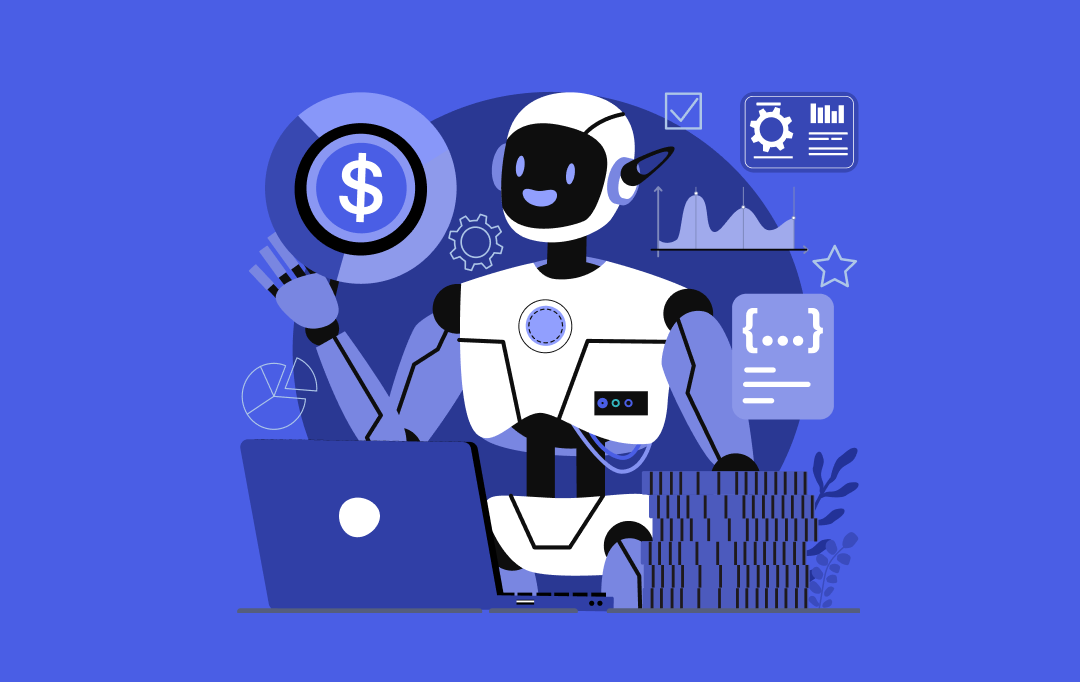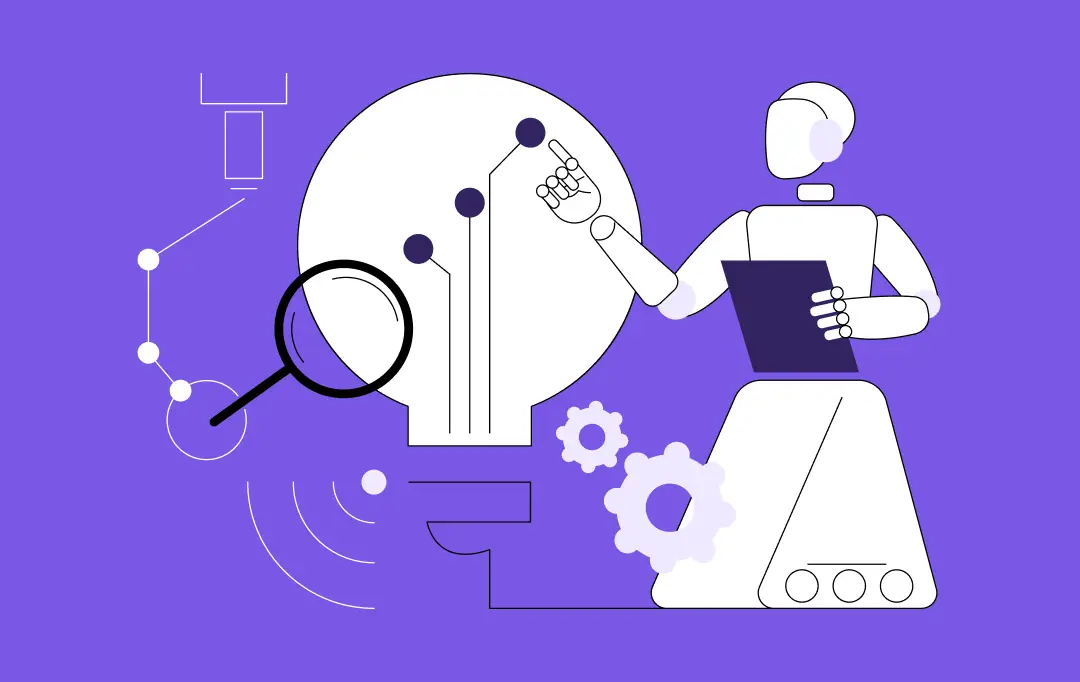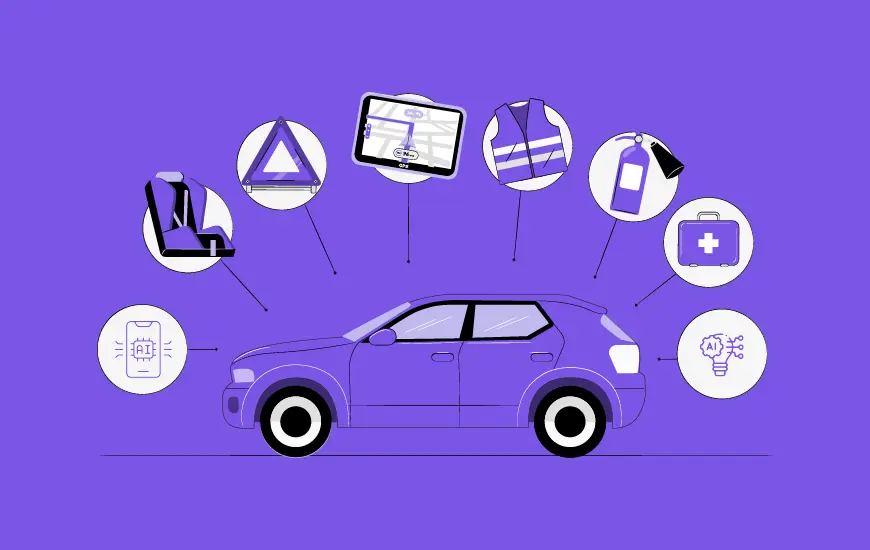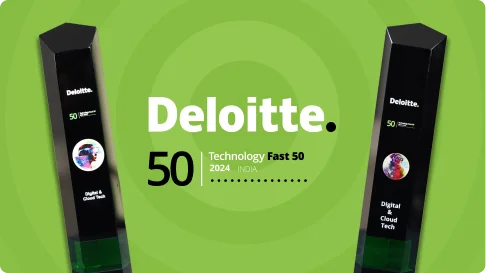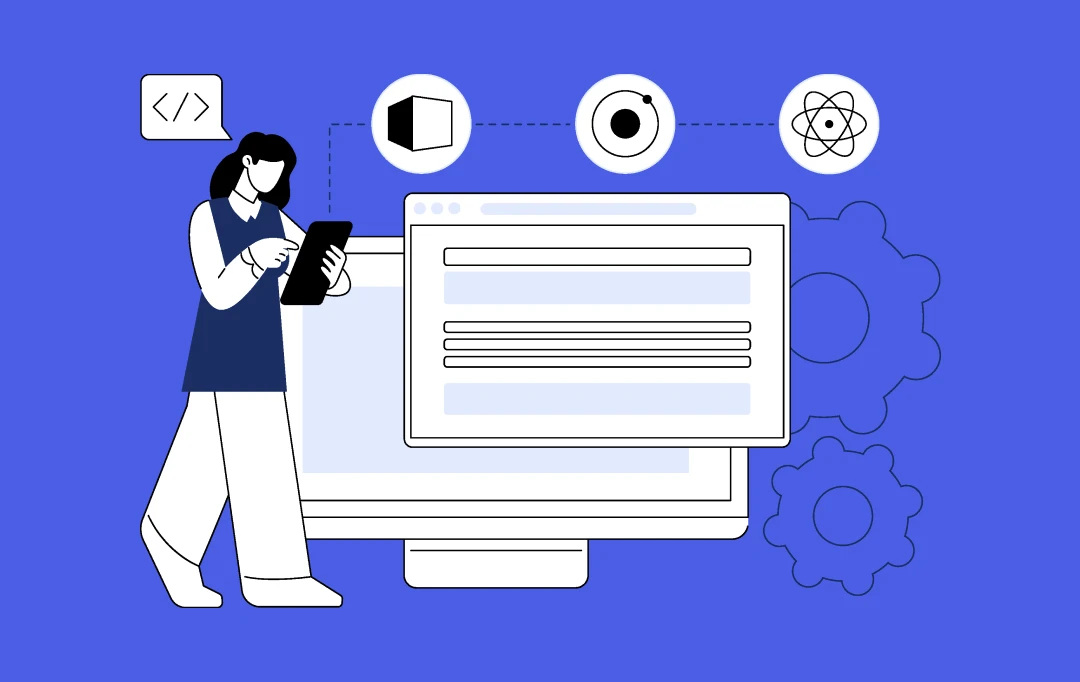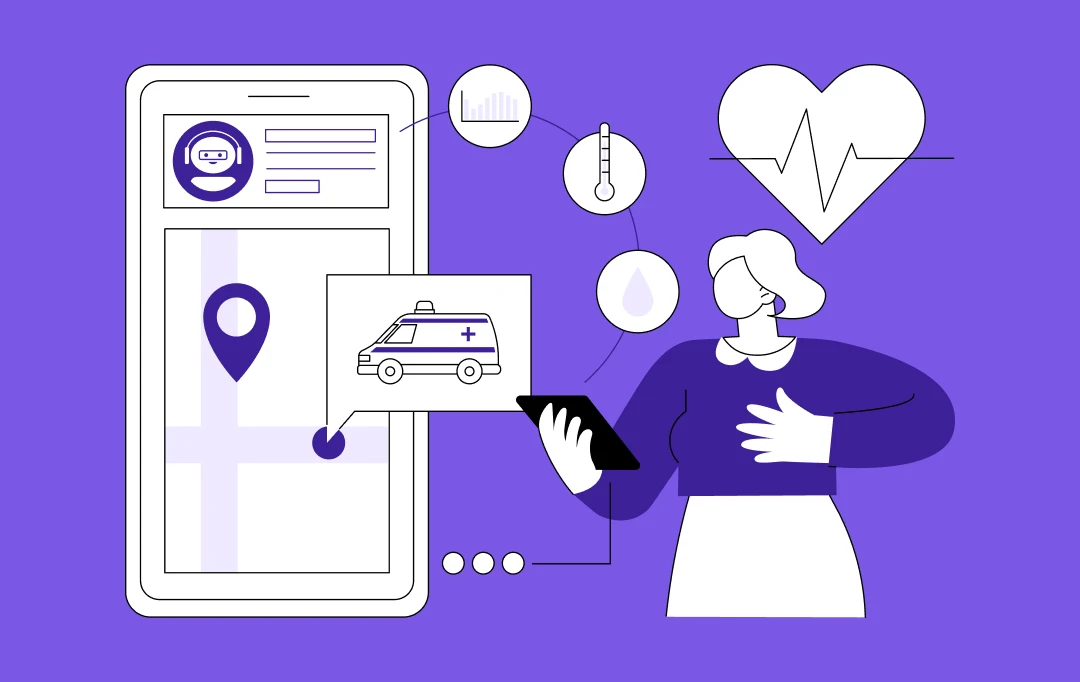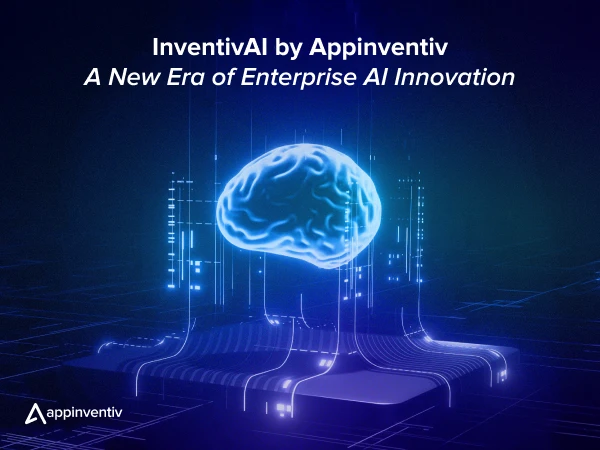- Why AI Agents in Customer Services Matter Today
- How Do AI Agents Work in Customer Handling
- Higher Intent Recognition
- Strategic Defence Capabilities Gathering
- Cross-Platform System Integration
- Management of Escalation Protocol
- Contextual Conversation Continuity
- Service Delivery Personalized
- Features of AI Agents For Customer Service
- Use Cases of AI Agents in Customer Service With Real-Life Examples
- 24/7 Automated Customer Support
- Personalized Product and Service Recommendations
- Automated Claims and Refund Processing
- Smart Call Routing
- Real-Time Support for Human Agents (AI Copilots)
- Multilingual Voice Support and Global Accessibility
- Sentiment Analysis and Escalation
- Seamless Omnichannel Support
- Proactive Customer Engagement
- Onboarding and Customer Education
- How to Successfully Deploy AI Agents for Seamless Customer Support
- Customer Service AI: Major Obstacles and Practical Solutions
- Reading Customer Emotions Stays Tough
- Data Protection and Privacy Issues
- Cookie-Cutter Responses Create Distance
- Data Security and Privacy Risks
- How Appinventiv is Shaping the Future of AI Agents in Customer Service: Emerging Trends
- FAQs
Key takeaways:
- AI agents are redefining the customer service experience by providing round-the-clock availability and instant responses.
- They personalize every interaction, making customers feel truly heard and valued.
- By taking over repetitive tasks, these agents help businesses reduce manpower costs while boosting operational efficiency.
- The best part? AI agents keep learning and improving. With every interaction, they get better at recognizing customer intent and offering more accurate, helpful responses.
Customer service has changed dramatically over the past few years, and AI agents are leading this shift. Look at Sephora – they brought in AI chatbots to help shoppers find products and get personal recommendations. The results speak for themselves: customer satisfaction jumped by 30%.
Companies today need to be both fast and personal, which is exactly why AI agents have become so important for round-the-clock customer service that actually delivers results. But this isn’t just about automated replies, it’s about creating personalized experiences in real-time that keep customers coming back.
We’re moving into a phase where AI feels like a normal part of how people connect with brands. Sephora isn’t alone in this either. Industrial names like Wendy’s and Mercedes-Benz are using specialized AI agents to transform their customer experiences. Wendy’s handles 50,000 food orders every day through their AI system, working in multiple languages with 95% accuracy. Again, Mercedes-Benz built an Automotive AI Agent into their MBUX Virtual Assistant for more natural, back-and-forth conversations. (Source: Google Cloud)
This trend isn’t limited to household names, though. Companies of all sizes are bringing in interactive AI agents to make their customer service smoother, reduce the load on human staff, and deliver consistent experiences that match their brand.
In this post, we’ll look at why AI agents in customer service matter so much, how they actually work, what features make them effective, real examples from different industries, common problems during setup, and what’s coming next for AI-powered customer support.
Let’s get started.
It’s your turn to embrace AI and elevate your support operations
Why AI Agents in Customer Services Matter Today
Customer expectations have gone through the roof these days. People want answers right now, and they want them tailored to their specific needs. The old model of waiting on hold for twenty minutes or dealing with limited business hours just doesn’t cut it anymore. That’s where AI agents like chatbots and virtual assistants come in – they’re available around the clock and can tackle basic questions without needing human backup. Businesses that make use of these AI agents experience a higher customer satisfaction rate with long-term retention.
Taking an example of how banks use Al agents to streamline customer service processes, here’s an illustration:
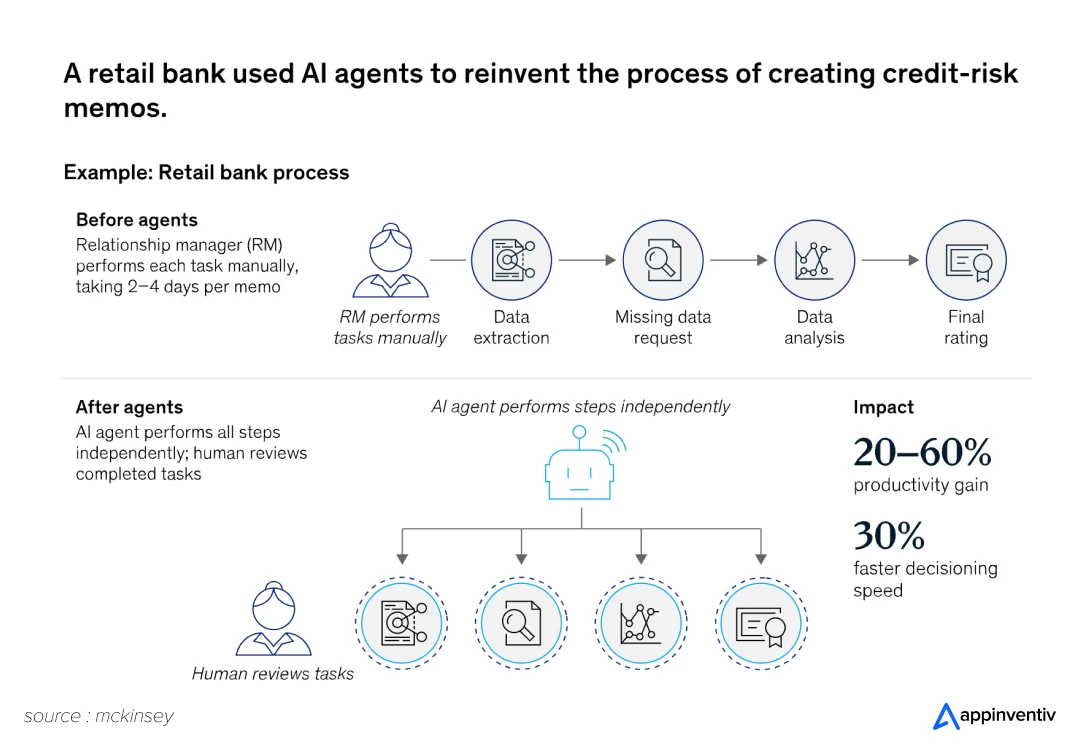
McKinsey illustrated this example of a retail bank where the relationship managers used to spend weeks putting together credit-risk reports by hand, gathering information from different systems, and building complicated arguments. After bringing in AI tools to pull data, write draft sections, rate confidence levels, and recommend next steps, the work changed from manual writing to strategic review—creating a 20–60% productivity boost and 30% faster credit processing.
This implies how AI agents can similarly transform customer service, automating routine inquiries, providing instant personalized responses, and freeing human agents to handle complex, high-value interactions that build stronger customer relationships.
Also, as per a GVR report, the global AI agents market is expected to reach a valuation of $50.31 billion by 2030, owing to the rising demand for 24/7 support, automation, NLP advancements, industry-specific use cases, and widespread digital transformation initiatives.
There’s another big reason businesses are jumping on the AI bandwagon: it saves money and makes everything run smoother. AI can juggle hundreds of customer questions at once and handle all those repetitive tasks that eat up so much time. Companies get to grow their customer base without hiring more staff or dealing with bigger overhead costs, all while keeping customers satisfied.
How Do AI Agents Work in Customer Handling
AI agents are designed to provide a full-service package to customers by handling their needs through the smart use of natural language processing and integrating systems. This is how these platforms work:
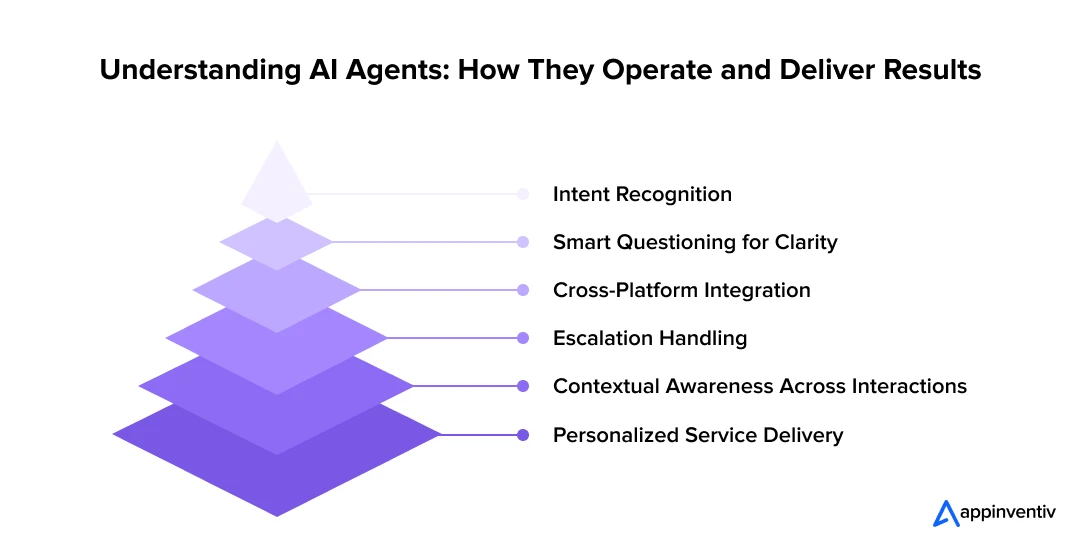
Higher Intent Recognition
As soon as customers resort to contacting the company with the use of any channel, AI agents conduct complex analyses of messages that go beyond mere matching of keywords. The system uses linguistic patterns, contextual clues and sentiment indicators in order to identify specific customer intent and the level of urgency. With this kind of analysis done, the accuracy of the responses is guaranteed and the necessary resources should be allocated at the earliest interaction.
Strategic Defence Capabilities Gathering
Contemporary AI agents use smart questioning procedures in cases where further clarification is needed. Instead of giving general answers, such systems are coming up with specific questions that are meant to collect information that will lead to resolution. Such an approach saves time in resolving the issue and minimizes customer effort, and also maintains professional standards of communication.
Cross-Platform System Integration
When there is clarity in customer needs, AI agents initiate multiple queries amid business systems they have been integrated to store, such as CRM platforms, inventory systems, order processing systems and knowledge stores. By being able to retrieve the utmost data, the agents can give full and accurate answers and take any necessary actions within the set limits.
Management of Escalation Protocol
AI agents contain advanced algorithms for decision-making that detect situations when human intervention is needed. Complex resolution efforts, sensitive account situations, and ask that require identification outside of predefined automation levels lead to direct contact with the correct human specialists in real-time without breaking the service delivery process.
Contextual Conversation Continuity
The systems have detailed interaction histories that make it possible to be contextually aware of the customer through various touchpoints. In a case where customers make follow-up requests, the agents draw on historical records of the previous conversation, attempted resolutions, and account changes, ensuring 24/7 customer service without the customer having to repeat information.
Service Delivery Personalized
The AI agents use the profiles of their customers, the history of their transactions, and behavior to tailor their engagement styles and suggestions to offer. Such data-driven personalization ensures that customer satisfaction remains high, the standards of a professional approach, and acceptable privacy levels are preserved.
Features of AI Agents For Customer Service
As businesses increasingly adopt automation, AI agents are transforming how customer service is delivered. Built with intuitive features, these agents are streamlining processes and driving productivity. Here are some of the top features of AI agents for customer service:
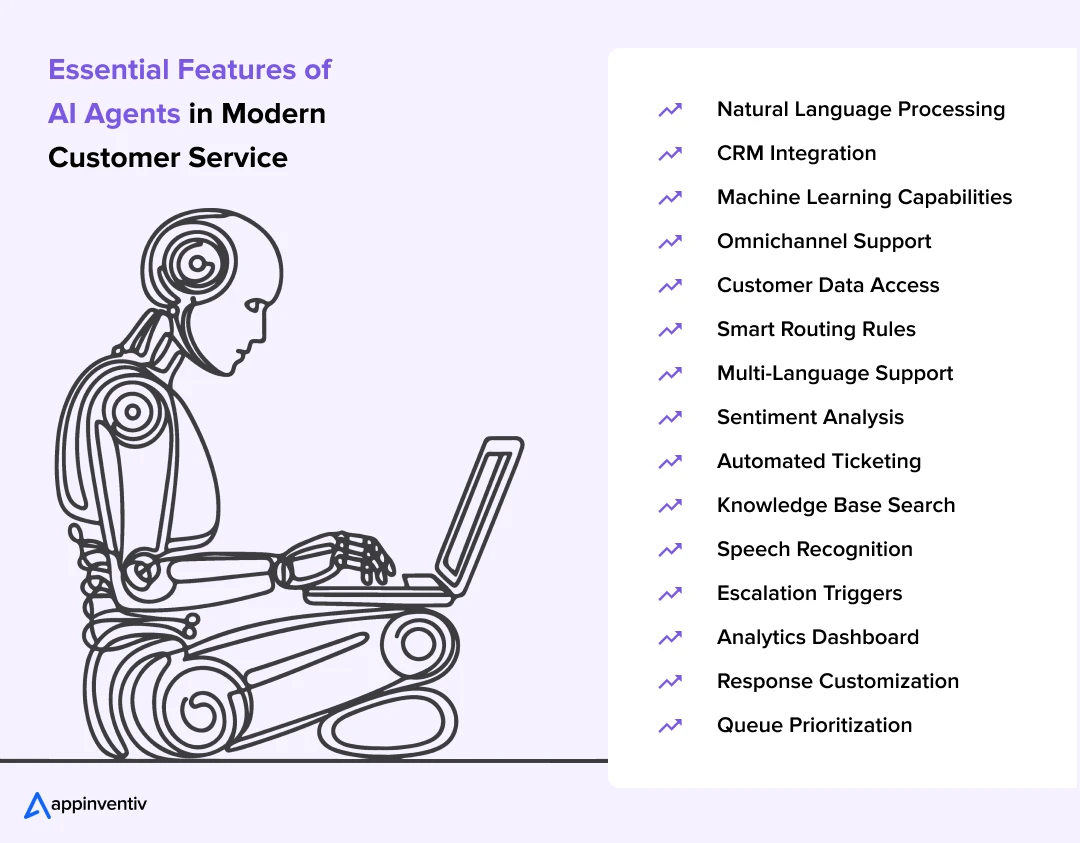
- Natural Language Processing: Understands and interprets customer messages in plain English without needing specific commands.
- CRM Integration: Connects directly with Salesforce, HubSpot, and other customer management systems you already use.
- Machine Learning Capabilities: Improves responses by studying successful conversations and adjusting based on outcomes.
- Omnichannel Support: Works across phone systems, live chat widgets, email platforms, and social media messaging.
- Customer Data Access: Retrieves purchase history, previous tickets, and account details during conversations.
- Smart Routing Rules: Transfers complicated issues to human agents based on keywords, sentiment, or complexity levels.
- Multi-Language Support: Communicates in over 50 languages without requiring separate language-specific training.
- Sentiment Analysis: Detects frustration, satisfaction, or confusion in customer messages and responds appropriately.
- Automated Ticketing: Creates support cases in your helpdesk system with proper categorization and priority settings using Automated ticketing.
- Knowledge Base Search: Searches through FAQs, product manuals, and company policies to find accurate answers.
- Speech Recognition: Converts voice calls into text and understands different accents and speaking patterns.
- Escalation Triggers: Identifies specific situations that require manager intervention and initiates transfers automatically.
- Analytics Dashboard: Tracks resolution rates, conversation length, customer satisfaction scores, and common issues.
- Response Customization: Modifies pre-written answers to match your company’s tone and specific customer situations.
- Queue Prioritization: Organizes incoming requests by customer tier, issue urgency, and business impact levels.
Use Cases of AI Agents in Customer Service With Real-Life Examples
Whether it’s chat support, behind-the-scenes automation, or voice calls, AI agents help companies grow without breaking the bank while keeping customers satisfied. Here are the main ways they’re being used, with real examples from actual businesses, each showing a specific benefit for search purposes.
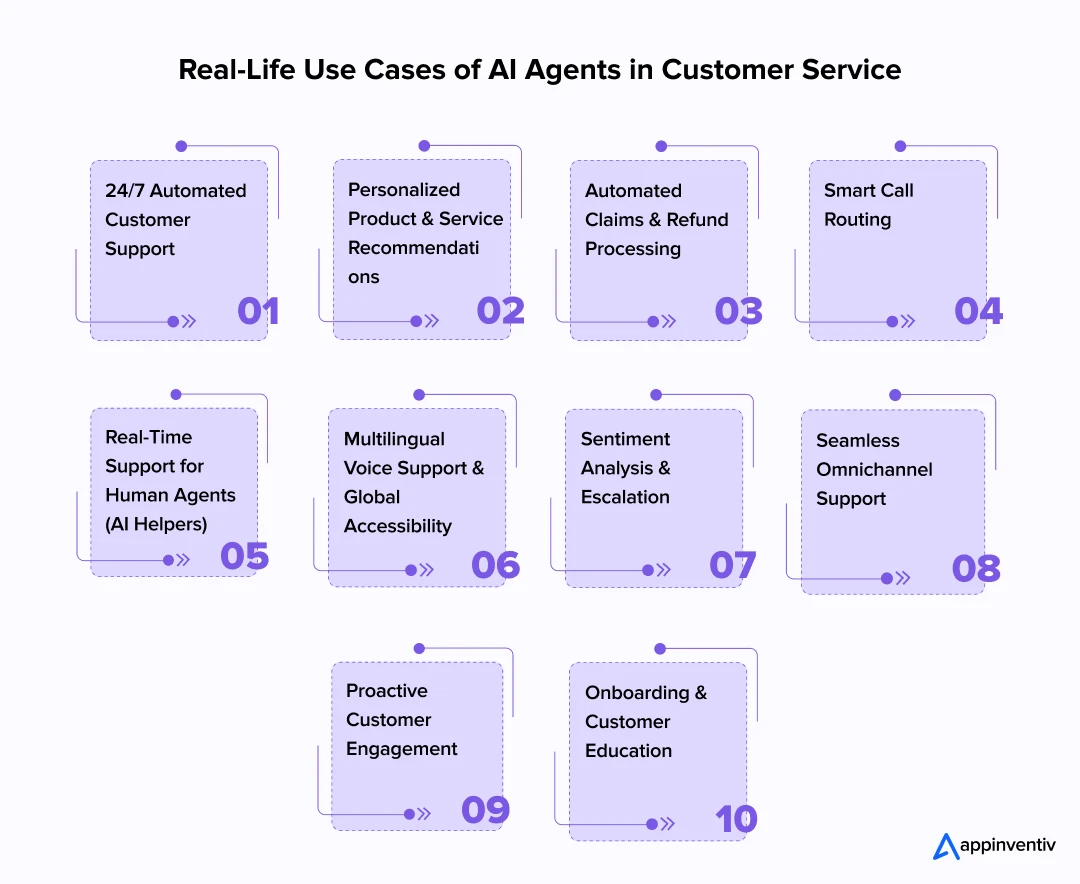
24/7 Automated Customer Support
AI agents are changing how support works by giving instant answers any time of day. They handle basic questions like order status checks, return requests, and FAQ responses without needing people to step in. This cuts down wait times and lets customers help themselves whenever they want. One of the key advantages of AI agent customer services is this always-on support that still maintains good service quality.
H&M, the worldwide clothing company, runs an AI chatbot on its website and mobile apps. The chatbot takes care of customer questions about order tracking, store stock, and return rules, even during big sales or after hours. By taking work off human agents, H&M keeps service consistent while helping customers in different time zones around the world.
Personalized Product and Service Recommendations
AI agents look at how customers behave, what they’ve bought before, and what they like to suggest products or services that actually make sense right when they’re shopping. This personal touch feels like talking to someone who really knows you and usually gets people to buy more and stick around longer. Companies with the best AI agent customer services use this personal approach to make shopping or getting help way better than just getting basic answers.
Sephora, a large beauty shopping brand, has an AI assistant in its web platform and app. It inquires users of the type of skin they have, the skin color, and what they need and recommends products that match them ideally, including videos on how to use the product and customer ratings. Not all of these are suggestions to every customer; they are aligned with the preferences of that particular customer and their previous purchases. Due to this, Sephora attracts more clients, sells larger purchases, and retains them.
Automated Claims and Refund Processing
AI agents, especially when they work with automated systems, take care of boring paperwork like checking claims, handling refunds, or making invoices. This gives human staff time to work on bigger problems and gets customers their money back way quicker. Many businesses now use AI agents in customer service, not just to chat with customers but to speed up the behind-the-scenes tasks that happen in the background.
Lufthansa, one of Europe’s major airlines, implemented an AI system that deals with flight compensation requests. When flights get delayed or cancelled, people can file claims on the website, and the AI checks if they deserve money, sorts through all the forms, and sends out payments. These kinds of tasks that took weeks before now get done in a few hours. This switch helped them cut costs and serve their passenger circle better.
Smart Call Routing
Instead of making customers navigate confusing phone menus or wait forever on hold, AI agents listen to what people say and determine the best course of action. This gets problems solved faster and keeps people from getting annoyed. The implementation of AI agent in customer services like smart routing doesn’t just make things run better—it keeps customers satisfied because they reach the right customer representative quicker.
Vodafone equipped a voice system based on AI to their call sector that hears what the clients want and passes them directly to the appropriate group tech support, billing, or account changing. This smart call routing arrangement enabled Vodafone to resolve so many issues in a single attempt and reduced the time people spend on their phones.
Real-Time Support for Human Agents (AI Copilots)
AI copilots enhance live customer support by instantly retrieving customer information, recommending responses, and sourcing relevant knowledge-base articles in real time. This enables human agents to work faster and with greater accuracy, particularly when handling complex or high-priority issues. This hybrid model demonstrates the value of agentic AI in customer service—where technology augments human capabilities without diminishing the personal connection customers expect.
At Appinventiv, our team built Mudra, an AI chatbot that makes budget management and expense tracking much simpler for everyday users. The interface works like having a regular conversation in real-time, which helps people plan their finances better and develop good money habits over time.

We take pride in how Mudra has expanded access to budgeting tools for individuals who previously lacked such resources. The app has seen rapid adoption and is now used in over 12 countries, empowering people to make informed financial decisions through intuitive, user-friendly technology.
Multilingual Voice Support and Global Accessibility
Global companies have to help customers who speak different languages, and AI agents are tackling this challenge through instant translation and local conversation styles. A voice AI agent for customer service can tell what language someone’s speaking, answer back in the same language, and adjust how it talks based on what people expect in that region. This breaks down language walls and keeps service quality the same, no matter where customers are calling from.
Alibaba operates multilingual AI voice agents to assist buyers and sellers on its site. These voice agents may switch among languages in the middle of the conversation, respond to the questions regarding the transaction, and clear up the shipping information in any language the customer would like. This aspect ensured that Alibaba expanded to other nations and maintained customer satisfaction in all the various markets in which it operates.
Sentiment Analysis and Escalation
Certain artificial intelligence agents utilizing sentiment analysis algorithms are quite effective at guessing the mood of people. Just by looking at the way somebody speaks and the words they use, the ways they mark things with a comma or a dash, and the speed of typing or speaking, they can know when a person is getting frustrated or stressed out or feeling good. As things begin to go in the wrong direction, the AI customer service agent notifies a human agent to intervene.
Zappos, famous for putting customers first, uses AI tools to monitor customer interactions in live chats and emails. If someone seems upset—like complaining over and over or using angry words, the system right away passes the case to an experienced human rep with all the background info. This approach ensures customers feel genuinely supported and valued, rather than dismissed by an impersonal automated system.
Seamless Omnichannel Support
People bounce around these days—they start chatting on a website, hop to an app, then send an email or call. AI agents track everything, so that the customers don’t need to repeat their whole story every time. Getting AI agents for seamless customer interactions means keeping all the details and chat records together wherever people decide to reach out.
Bank of America’s virtual assistant, Erica, once installed on a customer’s smartphone, analyzes interactions across the mobile app, website, and phone calls. For example, if a customer checks their balance in the app and then calls about a suspicious charge, Erica is already aware of the context, eliminating the need to repeat information. This streamlined experience saves time and delivers a more human-like interaction, despite the entire process being powered by software.
Proactive Customer Engagement
AI agents aren’t just sitting around waiting for problems anymore—they’re getting ahead of them. These smart systems contact customers with useful updates, reminders, or heads-ups before anything goes wrong. This changes customer service from fixing problems to stopping them, which builds better relationships and reduces the need for people to call for help. Proactive issue resolution is becoming a hallmark of the best AI agent customer services, where the focus is on driving strong customer relationships rather than merely resolving complaints.
Walmart, for example, uses AI-driven systems to notify online shoppers about order delays, product substitutions, or restocking dates before they need to reach out. By monitoring inventory levels, shipping timelines, and customer purchase patterns, the AI can proactively suggest alternative products, adjust delivery slots, or offer discounts through app notifications or emails. This keeps customer frustration low, reduces inbound queries, and turns potential service issues into moments of trust-building.
Onboarding and Customer Education
AI agents are now helping new customers get started—showing them around products, explaining how things work, and answering the usual beginner questions. This kind of automated help keeps people from giving up early, reduces confusion, and helps users actually get value from what they signed up for. This is where an AI customer service agent really pays off in the long run, not just when things break.
Canva, the design website, uses AI chat helpers and step-by-step guides to teach new users how to work with templates, branding stuff, and team features. The AI agent answers questions right away, points people toward tutorials based on what they’re doing, and even cheers when they finish tasks—making the whole learning process feel easy and encouraging. This approach gets people more involved and keeps them around from the very start.
Also Read: 20+ AI Agent Business Ideas in 2025 & Beyond
How to Successfully Deploy AI Agents for Seamless Customer Support
Getting AI agents up and running in your customer service department can boost efficiency, improve customer happiness, and cut costs. But this isn’t something you can just implement and hope for the best. Here’s what you need to do to make it work properly.
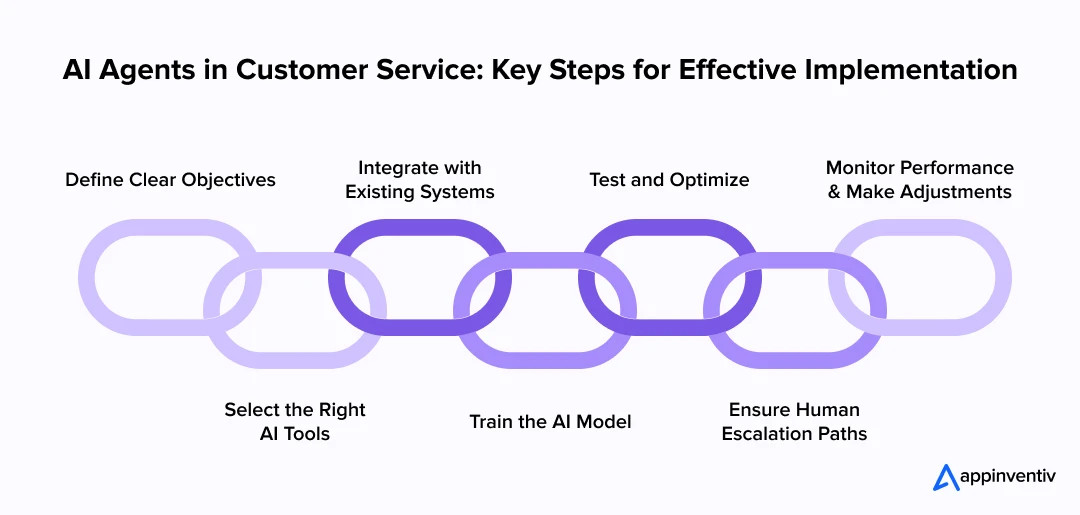
Define Clear Objectives: Figure out exactly what you want your AI agents to accomplish—faster response times, better first-call fixes, or more personalized interactions. This keeps every choice tied to business results you can track.
Select the Right AI Tools: Choose platforms that match your actual needs for features, scaling up, and working with what you already have. Consider language support, how well they understand regular conversation, and compatibility across different channels. Look at proven AI chatbots for customer service that have worked well for similar businesses.
Integrate with Existing Systems: Integrate AI agents with your CRM, help desk, and communication platforms so they can access live customer data and deliver consistent service across all customer interactions.
Train the AI Model: Feed relevant data, frequently asked questions, and conversation history into the system. Keep refreshing it with new information so agentic AI customer services stay accurate and contextually appropriate.
Test and Optimize: Start with small rollouts to evaluate how your agents perform. Collect input from customers and support teams, then tweak workflows, language processing, and escalation procedures for AI agent virtual assistants in customer service.
Ensure Human Escalation Paths: Establish clear triggers for sending complex or sensitive cases to human agents. This protects service standards and maintains personal connection for situations requiring empathy or careful decision-making.
Monitor Performance and Make Adjustments: Track metrics like resolution speed, customer satisfaction, and deflection rates. Use this data to continuously ensure the best AI agent customer services and other service outcomes.
Customer Service AI: Major Obstacles and Practical Solutions
While AI is revolutionizing customer support, its implementation comes with challenges like data accuracy, lack of human touch, and system integration issues. Addressing these challenges of implementing AI agents in customer service with practical, scalable solutions is key to unlocking its full potential in real-world service environments.
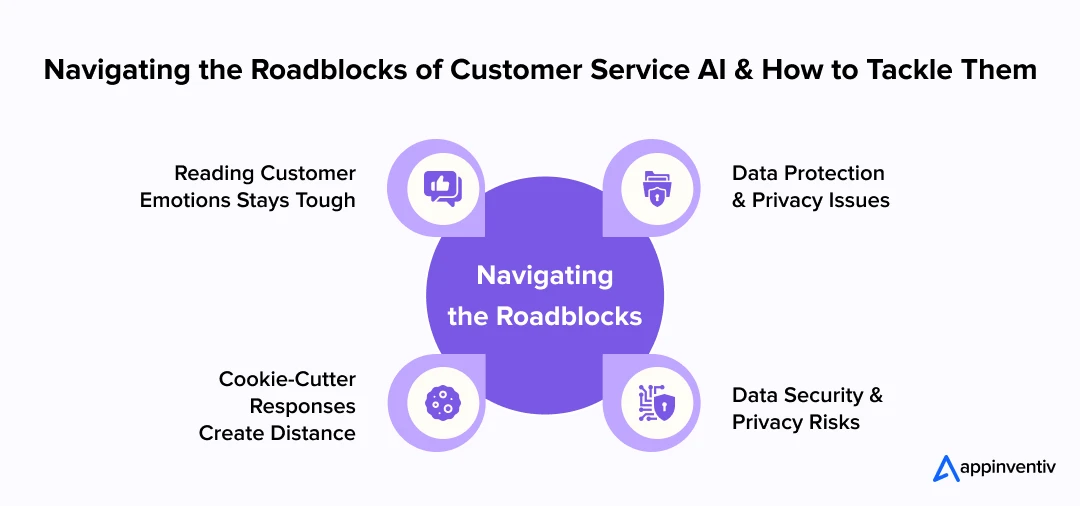
Reading Customer Emotions Stays Tough
- The Problem: Automated customer service systems regularly miss the emotional signals customers send during conversations. When people reach out for help, these tools overlook crucial signs like urgency, disappointment, or frustration, creating responses that customers find impersonal and useless. This issue gets worse when customers complain about products or services, or when they need support during tough situations.
- The Fix: Companies should build processes where emotionally complex cases go straight to human agents. Better sentiment detection helps AI customer service tools spot emotional cues and respond more suitably, but this technology needs regular updates to keep responses from sounding fake.
Data Protection and Privacy Issues
- The Problem: Keeping customer information safe has become vital as people learn more about their privacy rights. AI customer service systems without proper security can accidentally reveal private data or break regulatory rules, causing legal troubles and destroying customer trust.
- The Fix: Organizations must put strong security measures in place including encryption, protected data storage, and controlled access permissions. AI customer service platforms must follow regulations like GDPR from the start, while clear explanations of data practices help keep customer confidence.
Cookie-Cutter Responses Create Distance
- The Problem: Customers feel dismissed and unimportant when they get the same standard replies. When an AI customer service agent sends identical responses without considering the customer’s background or specific situation, it shows a clear disconnect from their actual needs and hurts overall satisfaction.
- The Fix: Smart personalization that considers someone’s preferences, past conversations, and buying patterns works through connections with customer databases and CRM systems. An AI customer service agent can use this information to deliver relevant, tailored responses that reflect each customer’s unique relationship with the company.
Data Security and Privacy Risks
- The Problem: Protecting customer information has become essential as people grow more concerned about their privacy rights. AI agent customer service automation without proper setup can expose sensitive details or violate regulatory standards, leading to legal complications and broken customer trust.
- The Fix: Strong security practices for AI agents, including encryption, protected storage methods, and limited access permissions, are absolutely necessary. AI agent customer service automation must meet regulations like GDPR right from the planning stage, while straightforward explanations about data handling help preserve customer confidence.
Our experts can help you navigate challenges and implement AI that delivers
How Appinventiv is Shaping the Future of AI Agents in Customer Service: Emerging Trends
As AI technology gets better, customer service is going through huge changes. Today’s AI agents don’t just answer basic questions anymore—they’re becoming smart, emotionally tuned systems that can handle complicated conversations across different platforms. These improvements are creating new expectations for how fast, personal, and efficient support should be. Here are the main trends of AI agent in customer service that show where things are heading:
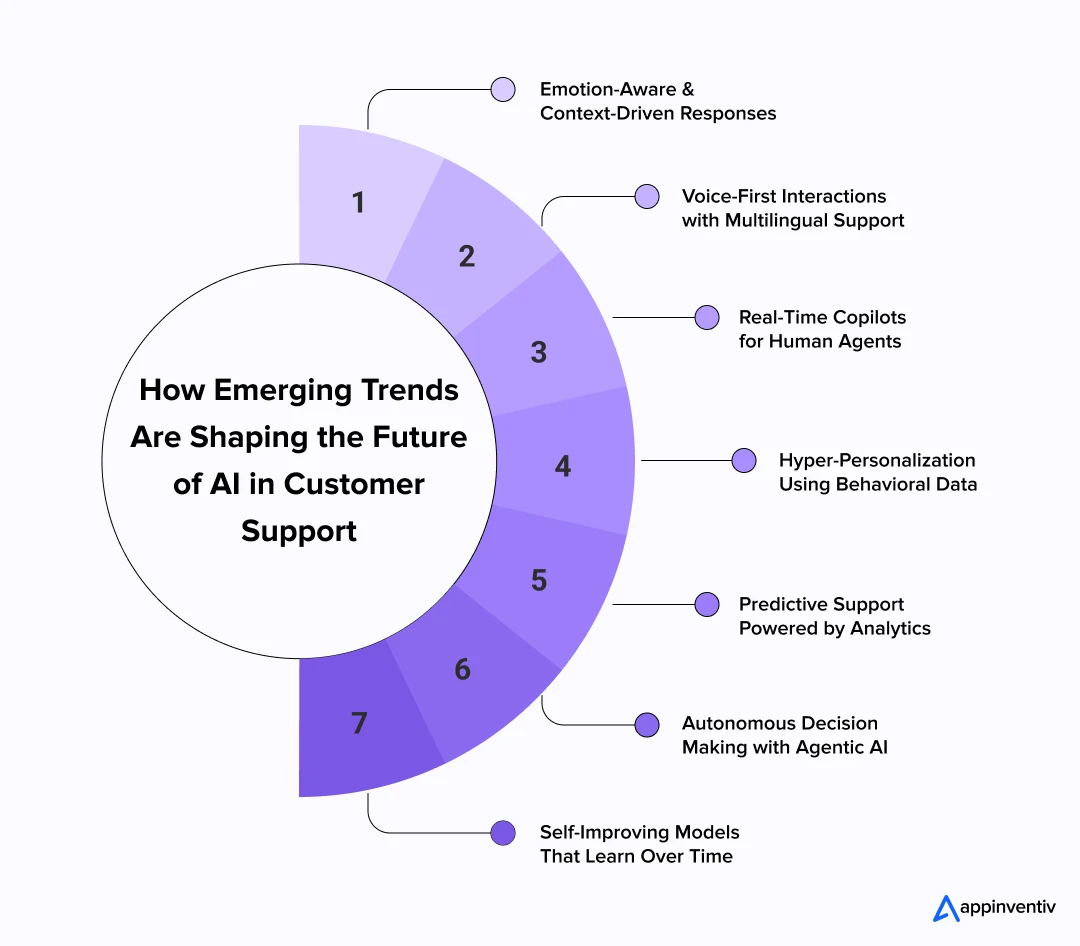
1. Emotion-Aware and Context-Driven Responses: AI agents are learning to pick up on mood, tone, and how urgent something is. This lets them change how they respond based on how the customer feels, making conversations feel more caring and human.
2. Voice-First Interactions with Multilingual Support: With more voice AI agents for customer service, people can talk naturally in whatever language they prefer. This trend makes support easier to use and more welcoming for different regions and groups.
3. Real-Time Copilots for Human Agents: AI co-pilots workflow transformation work alongside support reps during live chats by suggesting what to say, finding useful information, or figuring out what customers want. This fixes more problems on the first try and speeds up call times.
4. Hyper-Personalization Using Behavioral Data: Modern AI agents dig into customer records, preferences, and past behavior to customize recommendations and solutions. This level of personalization keeps customers loyal and makes them happier.
5. Predictive Support Powered by Analytics: Agentic AI customer services use prediction tools to guess what customers might need or catch issues before they blow up. This forward-thinking approach reduces hassles and keeps people around longer.
6. Autonomous Decision-Making with Agentic AI: These AI systems can act on their own—processing refunds, moving tickets up the chain, or updating records based on set rules and customer situations.
7. Self-Improving Models That Learn Over Time: The best AI agent customer services keep learning all the time. These systems get better based on actual conversations, improving how accurate, friendly, and efficient they areBuild Business-Ready AI Agents With Appinventiv’s Experts
Businesses today want more from AI than simple automation. They’re looking for tools that provide real-time insights, make independent decisions, and align with long-term goals. It’s about shifting from basic systems to smart solutions that understand context, adapt quickly, and handle key tasks with accuracy. AI isn’t just a support function anymore—it’s a core driver of growth, efficiency, and new ideas.
To meet these needs, AI agents must be designed with purpose. They should manage complex workflows, connect smoothly across platforms, and learn from data in real-time. At Appinventiv, we combine technical know-how with a focus on your business to create AI agents that are practical and effective.
As a reputed AI agent development services provider, we work closely with your team to grasp your operations and deliver solutions that fit your daily realities. We worked on various AI-based projects like JobGet, Americana ALMP, MyExec, Vyrb, and others, helping them digitally transform through impactful AI implementation.
From planning to launch and beyond, we prioritize scalability, ease of use, and clear results. We don’t build AI just to impress—we build it to solve real problems and bring lasting value to your organization.
The next wave of AI is more intuitive, better connected, and more in tune with what people need. With Appinventiv as your trusted AI services and solutions development partner, the future is here now.
FAQs
Q. How do AI agents enhance customer service?
A. AI agents in customer service provide substantial value by maintaining constant availability through chatbots, voice systems, and self-help portals. They respond to routine inquiries, guide clients through troubleshooting procedures, and tailor responses to specific customer histories and preferences. Improvements in customer satisfaction and speedier resolution times are seen as direct outcomes by businesses.
Q. Will AI agents replace human customer service reps?
A. Not completely. Although AI customer service agent technology performs well with routine questions and tasks, human agents are still required for more complicated situations, emotional concerns, and cases that require nuanced judgment. The majority of businesses use AI as a foundational support layer. This layer takes care of basic requests while human agents focus on more complex problems that require personal expertise and relationship management skills.
Q. What are some of the top types of AI agents?
A. There are different types of AI-driven customer support agents that support businesses in numerous ways. Here are some of them:
Chatbots: Chatbots have become the first approach to most websites. Chatbots address mundane requests, including tracking the package, resetting a password, and repetitive questions using text chat.
Voice Assistants: Voice-based AI agents that facilitate an easy conversation with customers through speech also make it possible to use them in call centers as well as hands-free operations since they work via voice commands. Like more common user applications, these systems can check the status of accounts, transfer calls where required, and give voice responses to common queries, which makes the service more conversational.
Intelligent Virtual Assistants (IVAs): IVAs are a more advanced form of AI-based virtual assistants in customer service that deliver beyond short-answer/ question skills. The systems understand conversational context, carry forward a conversation, and have access to various sources of data to provide personalised answers.
Robotic Process Automation (RPA): RPA systems perform work such as record updates and claim processing with the help of AI agents in customer service to ensure the smooth flow of information in platforms and minimize manual work.
AI Copilots: AI copilots are intelligent assistants that help the human agents in live interaction with real users. These systems provide recommendations, surface-level pertinent information, and assist the agents on complicated workflows with increased ease.
Q. What are some of the top benefits of AI agents in customer service?
A. Here are some of the top advantages of AI agent customer services:
Always Open for Business: Voice AI agent for customer service works around the clock without needing breaks or time off, so customers can get help whenever they want it. This means you never miss out on potential sales just because it’s after hours or on weekends. Your support stays consistent no matter what time zone your customers are in.
No More Waiting Around: AI agents in customer service answer questions right away, so customers don’t get stuck in long phone queues or waiting for email replies. People get their problems solved fast, which keeps them happy with your brand. Quick responses mean customers stick around instead of going to your competitors.
Saves Costs: Implementation of AI agent in customer services cuts down on staffing costs since routine questions get handled automatically. You can help more customers without hiring more people, which frees up the budget for other business needs. The money saved often pays for the technology itself pretty quickly.
Same Quality Every Time: Virtual agent for customer service gives the same helpful response whether it’s the first call of the day or the thousandth. You don’t have to worry about tired employees giving poor service or new staff making mistakes. Customers know they’ll get reliable help every single time they reach out.
Grow with Your Business: The best AI agent customer services can handle hundreds of customers at once without breaking a sweat. When you get busy during holidays or sales events, the system handles the extra volume easily. You don’t need to scramble for temporary workers or worry about overwhelmed staff.
Speaks Every Language: Agentic AI customer services can chat with customers in their native language without needing separate staff for each one. This opens up new markets and makes international customers feel welcome. Language barriers disappear, making your business truly global.


- In just 2 mins you will get a response
- Your idea is 100% protected by our Non Disclosure Agreement.

Why Enterprises Need AI Strategy Consulting in Dubai
Key takeaways: Dubai is moving fast with AI adoption. But many enterprises still struggle to move beyond pilots and achieve real business results. AI strategy consulting gives leaders a clear plan. From use-case selection to data readiness, so enterprise AI initiatives stay on track and within budget. AI consulting in Dubai helps enterprises reduce compliance…

AI Governance Consulting: How to Build Guardrails, Observability, and Responsible AI Pipelines
Key takeaways: Enterprises can no longer rely on principles alone; AI governance must be built into pipelines, model workflows, and decision systems from day one. Strong guardrails across training, inference, retrieval, and agentic actions reduce risks like hallucinations, data leakage, and prompt injection. AI observability is central to governance, giving leaders real-time visibility into drift,…

How to Build a Custom Multilingual Chatbot? Features, Process, Costs
Key takeaways: Multilingual Chatbots Drive Revenue Growth: Companies see higher conversion rates when customers can interact in their native language, with nearly 75% of global customers preferring to buy from websites in their preferred language. Beyond Translation to Cultural Intelligence: Successful implementations require cultural adaptation, not just language translation. Systems must understand context, emotion, and…
